|
|
|
| How are Interest Rates
Determined? |
- Interest rate -
- Borrowers - interest rate is a cost to borrow money
- Consumers borrow money to buy houses, cars, appliances, etc.
- Businesses borrow money to buy machines, equipment, and
structures
- Government borrows money when it has budget deficits
- Government spending > taxes
- Savers - interest rate is a benefit to savers
- Interest rate differs
- Maturity - when borrower makes last payment
- Number of payments
- Risk
- However, interest rates tend to move
together
- Example 1: A saver deposits $1,000 into a savings account that earns
15% (Annual Percentage Rate (APR). At the end of the year:
- Has $1,000 from the starting balance
- Earns $150 (=$1,000 X 0.15) in interest
- Ending balance is $1,150
- Example 2: A company borrows $10,000 from a bank and agrees to pay
the loan back plus $1,000 for interest.
- The business pays 10% interest (=$1,000 / $10,000)
- Example 3: A Treasury bill has a face value, but does not have a
stated interest rate on it.
- When the T-bill matures, the investor gets the face value.
- An investor pays $9,000 for a $10,000 T-bill.
- Investor earns $1,000 interest, or 10%
- The market price of the bond is $9,000
- If the investor pays $9,500 for the T-bill, he earns $500 in
interest or 5%.
 |
As market interest rates increase, market prices for bonds
decrease, and vice versa. |
- Demand for money
- Transaction demand - people
need money to make transactions
- Purchase groceries
- Pay rent
- Pay credit cards
- Precautionary demand - deal
with uncertainty
- Medical emergency
- Bail out a relative from jail, etc.
- Store value - retain future purchasing value
- Demand for money
- Demand for money is proportional to nominal GDP
- A larger economy requires more money
- Interest rate is an opportunity costs
- If people hold more money, they give up earning interest from a
bank
- At higher interest rates, people hold less money
- Example
- If savings rate is 1%, many people would not be concerned
about earning interest
- If savings rate is 15%, more people would deposit money into
banks to earn interest.
- Technology - changes in technology affect people's demand for
money
- Widespread use of credit cards and debit cards reduced people's
demand for money
- Relationship is shown below
- Real rate of interest is r
- Quantity of money, M

- Central bank supplies money (S)
- Can make decisions independent of interest rate
- Shown below
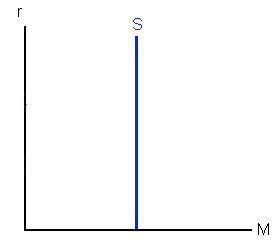
Equilibrium real interest rate is intersection of supply and
demand
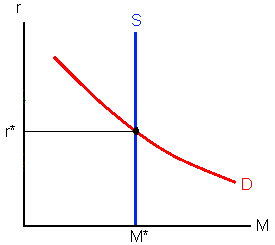
|
| The Fed's Balance
Sheet |
Federal Reserve has a balance sheet; the list is not comprehensive;
refer to my course, Money & Banking, for a more extensive
analysis
- The Fed’s Assets:
- Securities
- U.S. government securities, like Treasury bills, Treasury notes,
and Treasury bonds
- Discount Loans - the Fed loans funds to banks, helping the bank
overcome short-term financial problems.
- The Fed controls the interest rate on these loans
- The interest rate is called the discount rate.
- The Fed’s Liabilities and Capital Accounts:
- Currency Outstanding:
- Federal Reserve Notes - currency issued by the Fed, i.e. U.S.
money.
- Deposits by Depository Institutions
- Banks must hold required reserves in the form of vault cash
and/or deposits at the Fed.
- These deposits are assets to the depository institutions, but
liabilities to the Fed.
- U.S. Treasury Deposits - checking account for U.S. government
- The U.S. Treasury receives tax payments, collects fees,and sells
U.S. government securities
|
| Fed's Tools for Monetary
Policy |
|
- Expansionary monetary policy
- Federal Reserve increases the money supply
- Bank reserves increase
- Interest rates decrease (in short run)
- Federal Funds rate is impacted first
- Bond market prices decrease
- Below is market for money
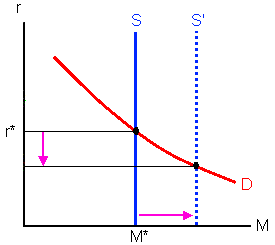
- Expansionary monetary policy
- An economy can grow faster
- A lower real interest rate causes businesses to invest more,
having a multiplier effect on economy
- Causes U.S. dollar to depreciate, which boosts the export sector
- Lower interest rates increase stock and bond prices, creating a
wealth effect.
- A larger money supply shifts the Aggregate Demand to the right
- Society may have demand pulled inflation
- Example - extremely low interest rates between 2000 and 2007
caused a real estate boom
- U.S. economy was growing from the massive investment in houses
- Property values were quickly climbing
- Housing bubble "popped" in 2007, and property values are quickly
falling.
- Many people used Adjustable-Rate Mortgages
- Mortgage interest rate changes with market interest
rates.
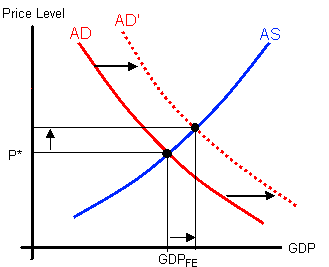
- Contractionary (Restrictive) monetary
policy
- Federal Reserve decreases the money supply
- Bank reserves decrease
- Interest rates increase (in short run)
- Federal Funds rates increases
- A real higher interest rate causes businesses to invest less
- A lower investment causes economy to grow slower.
- Bond market prices increase
- Below is market for money

- Contractionary monetary policy
- Slows the economy and to help lower inflation
- Price level may not fall, because prices tend to be inflexible
downward
- A smaller money supply shifts the Aggregate Demand to the left
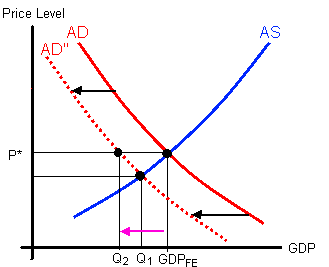
1. Open Market Operations
- Fed's most important tool
- Very flexible
- If Fed bought too many U.S. securities, it can turn around and
sell them.
- If Fed purchases U.S. government securities, bank reserves increase
- Expansionary monetary policy
- If Fed sells U.S. government securities, bank reserves decrease.
- Contractionary monetary policy
- Fed could buy any type of assets, but usually focuses on U.S.
government securities
- Fed buys U.S. securities from the private market
- The Fed is independent of the U.S. Treasury
- Buying directly from the U.S. Treasury could jeopardize the Fed's
independence.
- Example 1: Federal Reserve buys $50,000 in U.S. Treasury securities
from U.S. bank, the T-accounts are below:
- Bank reserves are a liability to the Fed
- Money supply increases and interest rates
decrease
U.S. Bank
| Assets |
Liabilities + Net
Worth |
| U.S. Treasury securities |
-$50,000 |
|
|
| Reserves at Fed |
+$50,000 |
|
|
Federal Reserve
| Assets |
Liabilities + Net
Worth |
| U.S. Treasury securities |
+$50,000 |
Bank Reserves |
+$50,000 |
U.S. Bank
| Assets |
Liabilities + Net
Worth |
| U.S. Treasury securities |
+$20,000 |
|
|
| Reserves at Fed |
-$20,000 |
|
|
Federal Reserve
| Assets |
Liabilities + Net
Worth |
| U.S. Treasury securities |
-$20,000 |
Bank Reserves |
-$20,000 |
2. Discount Rate
- The Fed can grant loans to financial institutions.
- The Fed sets the interest rate on the loan called the discount rate
- A bank may have to put up collateral for the Fed loan.
- If the Fed increases the discount rate, banks borrow less.
- Contractionary monetary policy
- If the Fed decreases the discount rate, banks borrow more.
- Expansionary monetary policy
- Benefits
- The Fed is the “Lender of the last resort.”
- If a bank has trouble with liquidity or needs reserves, the Fed is
the last place to go.
- The Fed extended credit to financial institutions during the stock
market crash in 1987, preventing a recession.
- Problems
- A bank may try to profit from a Fed loan. A bank may borrow from
the Fed at a low interest rate and grant loans for higher interest
rates.
- Borrowing from the Fed is a privilege and not a right!
- European central banks charge a higher interest rate than the
market rate, penalizing banks from borrowing from the central bank.
- Not a good tool for monetary policy.
- If Fed needs to increase money supply, it cannot force banks to
take loans.
- Example 3: Federal Reserve grants a $100,000 loan to U.S. Bank. The
transaction is shown below:
- Money supply increases and interest rates
decrease
U.S. Bank
| Assets |
Liabilities + Net
Worth |
| Reserves at Fed |
+$100,000 |
Fed loan |
+$100,000 |
Federal Reserve
| Assets |
Liabilities + Net
Worth |
| Loan to U.S. Bank |
+$100,000 |
Bank Reserves |
+$100,000 |
3. Reserve Requirements - the ratio of reserves to
deposits that banks must hold to satisfy depositors’ withdrawals.
- Not a good tool for monetary policy
- Small changes in the reserve requirements have a significant and
disruptive impact on the banking system
- i.e. the money multiplier
- The Fed rarely changes the reserve
- If the Fed raises the reserve requirments, banks have to hold more
reserves.
- Contractionary monetary policy
- If the Fed lowers reserve requirement, banks have excess reserves
and can grant more loans.
- Expansionary monetary policy
|
| Monetary Policy |
- Monetary policy - more flexible and faster than fiscal policy
- Congress can take a long time before implementing a policy.
- Federal Reserve Board for Fed meet regularly and can come up with
decisions quickly.
- Monetary policy suffers from the same lags as fiscal policy
- Recognition (or information)
lag - takes time to collect data
- Recession - two consecutive quarters of negative growth for real
GDP
- If government takes 3 months to collect data, then economy could
already be in a recession
- Administrative lag -
government requires time to make a decision
- The Fed can make decisions much quicker than Congress and the
President
- Impact lag - takes time for
the monetary policy to impact the economy
- Could be a from a six to twelve month delay for fiscal policy to
impact economy
- Monetary policy can become ineffective
- During 1990s, Japan went into a recession for a decade
- Business and consumers were so pessimistic, when the Japanese
central bank lowered the interest rate, it had no impact on the
economy.
- Cyclical asymmetry - the
belief the restrictive monetary policy is effective while expansionary
monetary is not so effective
- Low interest rates many not change behavior, but high interest
rates do.
- Central banks choose certain variables and use monetary policy to
achieve targets for those variables.
- Taylor Rule - Taylor developed
rules for the Federal Reserve that stabilized the Federal Funds rate.
- Inflation Target - central
banks maintain a low inflation rate
- Countries
- Canada
- New Zealand
- Sweden
- United Kingdom
 |
Countries that have central banks independent from government
have low inflation rates. | |
| Terminology |
- demand for money
- transaction demand
- precautionary demand
- expansionary monetary policy
- contractionary (restrictive) monetary policy
- open market operations
- discount rate
|
- reserve requirements
- recognition (information) lag
- administrative lag
- impact lag
- cyclical asymmetry
- inflation target
|
|







